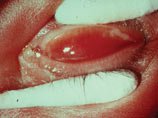Experts: Diagnosing and treating a purulent red eye in an infant
A panel of clinicians convened by OSN discuss how they would manage the case.
Eric D. Donnenfeld, MD: A 6-month-old healthy boy has an acute onset of red eye and purulent discharge. There is no history of trauma, systemic or maternal infection. What is the diagnosis?

Francis S. Mah, MD: It looks like bacterial conjunctivitis.
Dr. Donnenfeld: So how do you manage bacterial conjunctivitis in a 6-month-old? There are some new products available. What would you recommend, and what are your feelings?
|
| |||
Richard L. Lindstrom, MD: AzaSite (azithromycin ophthalmic solution 1%, Inspire Pharmaceuticals) might be a good choice for that patient.
Dr. Donnenfeld: Why do you say that?
Dr. Lindstrom: It works against the bugs that are most likely causing the problem.
Dr. Donnenfeld: And it is also, I think, effective because of its consistency due to the DuraSite vehicle. Kids cannot cry it out the way they can with antibiotic eye drops. It is more of a gel. It adheres to the tissue better, without the blurring. Equally important is the dosing schedule. At Manhattan Eye and Ear Hospital, when kids came in it was often difficult to put drops in their eyes and we would bundle them in a papoose. If you can dose them once a day vs. three or four times a day, that is a significant advantage. So I think this is a drug that makes sense, certainly in pediatrics for compliance and convenience.
|
Image: Donnenfeld ED |
Terry Kim, MD: Usually the most common organisms causing bacterial conjunctivitis in children include Haemophilus, Streptococcus pneumoniae, as well as Staphylococcus species. I would favor the use of a fourth-generation fluoroquinolone such as moxifloxacin because of its proven efficacy against these gram-positive and gram- negative organisms as well as its superior conjunctival penetration. But the dosing schedule and gel formulation of azithromycin are attractive features as well.
Dr. Lindstrom: Should the comprehensive ophthalmologist culture that?
Dr. Kim: The comprehensive ophthalmologist? No.
Dr. Donnenfeld: Good. So the diagnosis and management here is an antibiotic drop, and certainly, the old standby is a fourth- generation fluoroquinolone, which is still a reasonable therapy. But I think AzaSite may have some advantages, and we will see how it all plays out.
For more information:
- Eric D. Donnenfeld, MD, can be reached at OCLI, 2000 North Village Ave., Rockville Centre, NY 11570; 516-766-2519; fax: 516-766-3714; e-mail: eddoph@aol.com. Dr. Donnenfeld is a consultant for Alcon, Allergan, InSite and Inspire.
- Terry Kim, MD, can be reached at Duke University Eye Center, Erwin Road, P.O. Box 3802, Durham, NC 27710-3802; 919-681-3568; fax: 919-681-7661; e-mail: terry.kim@duke.edu. Dr. Kim is a consultant for Alcon and Allergan.
- Richard L. Lindstrom, MD, can be reached at Minnesota Eye Consultants, 9801 DuPont Ave. S, Suite 200, Bloomington, MN 55431; 952-888-5800; fax: 952-567-6182; e-mail: rllindstrom@mneye.com. Dr. Lindstrom is a consultant for Alcon.
- Francis S. Mah, MD, can be reached at University of Pittsburgh Medical Center, Eye and Ear Institute, 203 Lothrop St., 8th Floor, Pittsburgh, PA 15213; 412-647-2200; fax: 412-647-5119; e-mail: mahfs@upmc.edu. Ocular Surgery News could not confirm whether Dr. Mah has a direct financial interest in the products mentioned or if he is a paid consultant for any companies mentioned.

 Eric D. Donnenfeld
Eric D. Donnenfeld